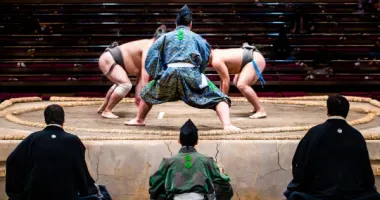Kodaira Furusato Mura Open Air Museum
The Kodaira Furusato Mura Open Air Museum is a collection of preserved, historic buildings from the Edo, Meiji and Taisho periods in Kodaira, Tokyo.
Kodaira Furusato Mura, Kodaira, Tokyo
小平ふるさと村 小平 東京
by Johannes Schonherr
 Kodaira Furusato Mura, Kodaira, Tokyo
Kodaira Furusato Mura, Kodaira, Tokyo
Today, Kodaira city in western Tokyo is largely a commuter dormitory town, comprised of low rise buildings with many parks here and there.
Located on the flat Musashino Plain, the area belonged in ancient times to Musashino Province which spanned most of what is today's Saitama Prefecture and western Tokyo.
 Drawing of the Old Ogawa Residence from the year Meiji 21 (1888)
Drawing of the Old Ogawa Residence from the year Meiji 21 (1888) Green Road turns into a sakura tunnel during cherry blossom season
Green Road turns into a sakura tunnel during cherry blossom season
Only after the completion of the Tamagawa Josui freshwater canal in the early Edo Period (in 1654 to be exact), did settlers move into the area.
They erected their first buildings and started their first farms at the intersection of the canal with the Ome Kaido, the old road connecting Edo (today's Tokyo) with Ome and Kofu. The Ome Kaido served as a shortcut for the Nakasendo Highway, the new canal provided a steady flow of irrigation water.
The land was rich and the newly formed village spread out. Soon, the most successful farmers were able to build impressive houses to live in, surrounded by stables, storage buildings and other structures. Businesses offering necessary services, like, say, water mills processing the harvested grain, were established along with the settlement of the area.
When Kodaira became a modern suburb of Tokyo in the 1970's, many of those old structures were torn down. Some of them were not simply discarded but meticulously taken apart and donated to the city.
In the early 1990's, Kodaira city re-erected those old buildings in an attempt to re-create a sort of Kodaira Musashino Village in the way villages looked back in the old times. The result was the Kodaira Furusato Mura Open Air Museum.
 Main House of the Old Koyama Estate, Kodaira Furusato Mura
Main House of the Old Koyama Estate, Kodaira Furusato Mura The kitchen inside the Old Koyama House with kamado stove
The kitchen inside the Old Koyama House with kamado stove
Green Road
The Kodaira Furusato Mura is located about halfway between Hana Koganei and Kodaira stations of the Seibu Shinjuku / Seibu Haijima Line. Signs point out that the distance between the two stations is 2.6 kilometers.
Leave Hana Koganei Station through its south exit and take the first road to the right once you have crossed the station square.
Actually, Green Road is not a real road. It's a bicycle / pedestrian path that is part of the Tamako Jitenshahokoshado (Tama Lake Bicycling / Walking Path), a much longer Tokyo city hiking / biking trail.
Green Road is lined with vintage cherry trees. During the sakura season in late March / early April, the pedestrian / cycling road will become a long cherry blossom tunnel.
There are several small parks along the path, the Takenoko Bamboo Grove being perhaps the most attractive.
 Recreation of an early settlement structure
Recreation of an early settlement structure Water Mill, Kodaira Furusato Mura
Water Mill, Kodaira Furusato Mura
Furusato Mura
Furusato Mura translates as "home village". The word furusato has a very special meaning in Japanese. It's the home town or village people have left behind in their pursuit of modernity and urban life.
Once they leave that modern urban life, though, they become sentimental about their old home and develop a yearning for it - without actually going back. Many Japanese songs reflect those feelings.
Strong feelings for the furusato, the home abandoned, sit especially deep with the immediate post-war generation, the generation that moved to the urban centers for jobs and opportunities in the times of Japan's feverish industrialization from the 1950's to the 1970's.
 The mill ground various kinds of grains
The mill ground various kinds of grains Former entrance to the Ogawa Residence
Former entrance to the Ogawa Residence
Visiting the Kodaira Furusato Mura
Admission to the Kodaira Furusato Mura is free. Just walk in and have a look. You might however want to enter the "village office" just on the right of the entrance to obtain a free English language pamphlet first. It gives you a good overview of the exhibits. Most of the buildings on site feature more detailed displays of their history in English.
The Furusato Mura is arranged like a real old village. The main building is the Old Koyama Estate, dating back to the second half of the 1700's. The Koyama were a wealthy family and the building reflects their status. You can enter and see their living arrangements, their kitchen as well as various farm tools dating back to their time.
The Suzuki Grain Storage is another original building, as is the entrance to the Old Ogawa Residence. In the latter case, only the entrance, not the whole house was donated to the museum.
Other buildings, including an example of a "First Settlement Structure" and a water mill, were re-created based on old documents.
The post office next to the entrance is of much more recent vintage, dating back to the late Taisho Era (1912 - 1926) when telephones and telegraphs were already in use. This too is an original building - it had to be moved only a few hundred meters to find its place at the Furusato Mura.
Though not as large as the Edo-Tokyo Open Air Architectural Museum in neighboring Koganei city, the Kodaira Furusato Mura makes for an interesting stroll through an ancient slice of Japanese history.
Kodaira Furusato Mura Information
Opening times: 10 am to 4 pm. Closed on Monday and the third Tuesday in the month. If those days fall on a public holiday, the village will be closed on the next day. Closed also over the New Year Holidays (December 27th - January 5th).
Admission: free
Tel. 0423 45 8155
Address: Tokyo, Kodaira-shi, Tenjin-cho 2-57
Kodaira Furusato Mura: kodaira-furusatomura.jp (in Japanese)
 Entrance to the Kodaira Furusato Mura with post office on the left and visitor center on the right
Entrance to the Kodaira Furusato Mura with post office on the left and visitor center on the right
Access
Take a Seibu Shinjuku or Seibu Haijima Line train from Seibu Shinjuku Station or Takadanobaba to Hana Koganei or Kodaira Station. Take the south exit on either of the latter stations and walk from there on the Green Road. The Kodaira Furusato Mura is about halfway between the two stations, about 1.3 kilometers from either station.
Related Articles
Kasukabe Underground Flood Protection Tank
Tokyo Water Science Museum
Tokyo Waterworks Historical Museum
Toto Toilet Museum
Sewerage Museum





























